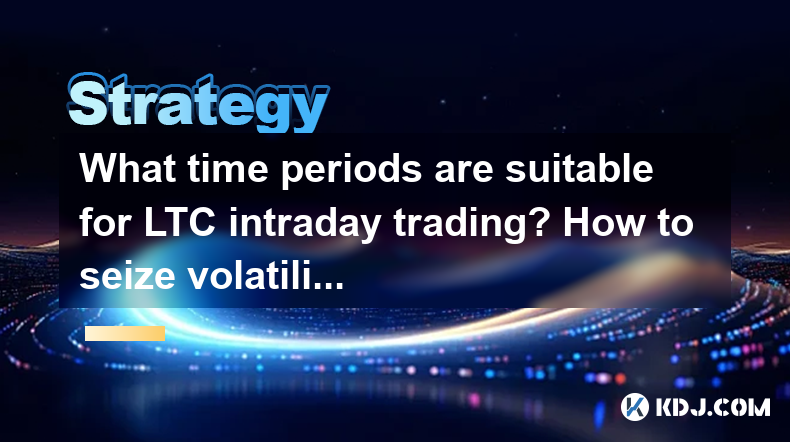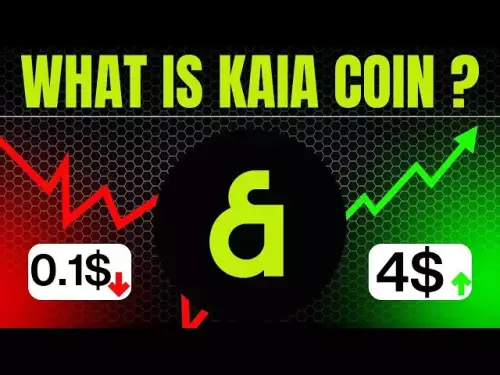-
 bitcoin
bitcoin $112715.707551 USD
-1.71% -
 ethereum
ethereum $4101.475385 USD
-3.01% -
 tether
tether $1.000644 USD
-0.02% -
 bnb
bnb $1207.619465 USD
-6.77% -
 xrp
xrp $2.501451 USD
-3.98% -
 solana
solana $202.947124 USD
-3.32% -
 usd-coin
usd-coin $1.000295 USD
0.04% -
 dogecoin
dogecoin $0.203884 USD
-4.47% -
 tron
tron $0.317154 USD
-1.72% -
 cardano
cardano $0.695009 USD
-4.43% -
 hyperliquid
hyperliquid $38.853961 USD
-8.23% -
 chainlink
chainlink $18.988674 USD
-4.64% -
 ethena-usde
ethena-usde $1.000233 USD
-0.03% -
 stellar
stellar $0.337050 USD
-3.63% -
 bitcoin-cash
bitcoin-cash $536.861728 USD
-1.28%
What time periods are suitable for LTC intraday trading? How to seize volatility opportunities?
Optimal LTC intraday trading times are during high volatility periods like early US session (9:30-11 AM EST) and late afternoon (2-4 PM EST). Use technical analysis and news trading to capitalize on price movements.
Apr 30, 2025 at 06:35 am

When engaging in Litecoin (LTC) intraday trading, selecting the right time periods is crucial for maximizing profitability and minimizing risk. Intraday trading, also known as day trading, involves buying and selling LTC within the same trading day to take advantage of short-term price movements. Understanding the optimal time frames and strategies to seize volatility opportunities can significantly enhance a trader's success rate.
Understanding LTC Volatility and Market HoursLitecoin, like other cryptocurrencies, experiences significant volatility, which can be both a risk and an opportunity for intraday traders. Volatility in the LTC market is influenced by several factors, including news releases, market sentiment, and broader economic indicators. To effectively trade LTC intraday, it's essential to understand when the market is most active and volatile.
The cryptocurrency market operates 24/7, but certain hours see more trading activity and volatility. Typically, the most active periods for LTC trading coincide with the opening hours of major global financial markets. These include:
- New York trading session (9:30 AM to 4:00 PM EST): This period often sees increased volatility due to the overlap with European trading hours and the release of significant economic data from the US.
- London trading session (8:00 AM to 4:30 PM GMT): As one of the largest financial centers, London's trading hours often lead to heightened activity in the LTC market.
- Asian trading session (7:00 AM to 4:00 PM JST): This session, particularly the overlap with European markets, can also see significant movements in LTC prices.
For LTC intraday trading, the most suitable time periods are typically those with the highest liquidity and volatility. Based on market activity and historical data, the following time frames are often considered optimal:
- Early morning US session (9:30 AM to 11:00 AM EST): This period often sees the initial market reactions to overnight news and data releases, leading to increased volatility.
- Midday US session (12:00 PM to 2:00 PM EST): This time frame can be volatile due to the overlap with European markets and the release of important economic indicators.
- Late afternoon US session (2:00 PM to 4:00 PM EST): As the US session winds down, there can be significant price movements as traders adjust their positions before the market closes.
To effectively seize volatility opportunities in LTC intraday trading, traders need to employ robust strategies. Here are some key approaches:
- Technical Analysis: Utilizing technical indicators such as moving averages, RSI, and Bollinger Bands can help identify potential entry and exit points. For instance, a crossover of the 50-day and 200-day moving averages can signal a potential trend reversal, providing an opportunity for intraday trading.
- News Trading: Keeping an eye on news releases and market sentiment can be crucial. Economic reports, regulatory news, and developments in the broader cryptocurrency market can significantly impact LTC prices. Traders can use this information to anticipate and capitalize on price movements.
- Scalping: This strategy involves making numerous small trades throughout the day to profit from minor price changes. Scalpers often use short time frames like 1-minute or 5-minute charts to identify quick trading opportunities.
To implement these strategies effectively, traders should follow a structured approach. Here are the detailed steps for LTC intraday trading:
- Choose a Reliable Trading Platform: Select a platform that offers real-time data, low latency, and robust charting tools. Popular options include Binance, Coinbase Pro, and Kraken.
- Set Up Your Trading Environment: Ensure your trading setup includes multiple monitors for real-time data, news feeds, and technical analysis tools. A stable internet connection is crucial to avoid delays in executing trades.
- Monitor Market Hours and Volatility: Use a trading calendar to track the opening and closing times of major markets. Set alerts for key economic releases and news events that could impact LTC prices.
- Analyze Technical Indicators: Use technical analysis to identify potential trading opportunities. For example, look for overbought or oversold conditions using the RSI to determine entry and exit points.
- Execute Trades: Once you've identified a trading opportunity, execute your trade quickly. Use limit orders to ensure you enter the market at your desired price.
- Monitor and Adjust: Continuously monitor your trades and be ready to adjust your positions based on market movements. Set stop-loss orders to manage risk and protect your capital.
Effective risk management is essential for long-term success in LTC intraday trading. Here are some key principles to follow:
- Set Clear Risk-Reward Ratios: Before entering a trade, determine your risk-reward ratio. A common ratio is 1:2, meaning you aim to make twice as much profit as you are willing to risk.
- Use Stop-Loss Orders: Always set stop-loss orders to limit potential losses. Place your stop-loss at a level that invalidates your trading thesis.
- Diversify Your Trades: Avoid putting all your capital into a single trade. Diversify across different time frames and strategies to spread risk.
- Keep Emotions in Check: Emotional trading can lead to poor decision-making. Stick to your trading plan and avoid chasing losses.
To enhance your LTC intraday trading, consider using the following tools and resources:
- TradingView: A popular platform for charting and technical analysis, offering a wide range of indicators and drawing tools.
- Crypto News Aggregators: Websites like CoinDesk and CryptoSlate provide real-time news and analysis that can impact LTC prices.
- Trading Bots: Automated trading bots can help execute trades based on predefined criteria, reducing the need for constant monitoring.
- Educational Resources: Books, courses, and webinars on cryptocurrency trading can provide valuable insights and strategies. Recommended resources include 'Cryptoassets: The Innovative Investor's Guide to Bitcoin and Beyond' by Chris Burniske and Jack Tatar.
A1: Identifying the best entry and exit points involves a combination of technical analysis and market awareness. Use technical indicators like moving averages and RSI to spot potential reversals or continuations. Additionally, monitor news and economic releases that could impact LTC prices, and use these insights to time your trades effectively.
Q2: What are the common pitfalls to avoid in LTC intraday trading?A2: Common pitfalls include overtrading, not setting stop-loss orders, and letting emotions drive trading decisions. To avoid these, stick to a well-defined trading plan, manage your risk carefully, and maintain discipline in your trading approach.
Q3: Can I use automated trading bots for LTC intraday trading?A3: Yes, automated trading bots can be used for LTC intraday trading. These bots can execute trades based on predefined criteria, helping to take advantage of volatility without constant monitoring. However, it's important to thoroughly test and monitor any bot to ensure it aligns with your trading strategy and risk tolerance.
Q4: How important is it to stay updated with LTC news for intraday trading?A4: Staying updated with LTC news is crucial for intraday trading. News and market sentiment can significantly impact LTC prices, and being aware of these factors can help you anticipate and react to price movements more effectively. Use reliable news sources and set up alerts for key events to stay informed.
Disclaimer:info@kdj.com
The information provided is not trading advice. kdj.com does not assume any responsibility for any investments made based on the information provided in this article. Cryptocurrencies are highly volatile and it is highly recommended that you invest with caution after thorough research!
If you believe that the content used on this website infringes your copyright, please contact us immediately (info@kdj.com) and we will delete it promptly.
- Dogecoin vs. Remittix: A Tale of Two Cryptos and the Price Outlook
- 2025-10-15 14:25:17
- ZORA, BTC, and Zcash: Riding the Crypto Rollercoaster with Robinhood and Whale Watching
- 2025-10-15 14:25:17
- Deutsche Bank, Bitcoin, and Central Banks: A New Era of Digital Finance?
- 2025-10-15 14:45:14
- Navigating the Crypto Landscape: Altseason 2025 and Beyond
- 2025-10-15 14:45:14
- Meme Coins Face-Off: SHIB, FLOKI, and the Rise of New Contenders
- 2025-10-15 14:50:02
- Beatrix Potter 50p Coin Sale: A Nostalgic Hunt for Treasure
- 2025-10-15 14:30:00
Related knowledge

Practical parameter settings for a Bitcoin multi-timeframe moving average system
Sep 18,2025 at 10:54pm
Optimizing Timeframe Combinations for Bitcoin Trading1. Selecting appropriate timeframes is crucial when building a multi-timeframe moving average sys...

How can I filter out false breakouts in Dogecoin high-frequency trading?
Sep 22,2025 at 01:00am
Understanding False Breakouts in Dogecoin Trading1. A false breakout occurs when Dogecoin's price appears to move beyond a defined support or resistan...

Techniques for identifying tops and bottoms in the Bitcoin on-chain NVT model
Sep 20,2025 at 07:54pm
Understanding the NVT Model in Bitcoin Analysis1. The Network Value to Transactions (NVT) ratio is often described as the 'P/E ratio' of the cryptocur...

What does the surge in open interest in Bitcoincoin futures mean?
Sep 20,2025 at 11:18pm
Understanding the Surge in Dogecoin Futures Open Interest1. A surge in open interest within Dogecoin futures indicates a growing number of active cont...

How can I use the Ethereum USDT premium to gauge market sentiment?
Sep 18,2025 at 11:55pm
Understanding the Ethereum USDT Premium1. The Ethereum USDT premium refers to the price difference between USDT (Tether) traded on Ethereum-based plat...

What should I do if Ethereum staking yields decline?
Sep 20,2025 at 06:18am
Understanding the Causes Behind Declining Ethereum Staking Yields1. The Ethereum network transitioned to a proof-of-stake consensus mechanism with the...

Practical parameter settings for a Bitcoin multi-timeframe moving average system
Sep 18,2025 at 10:54pm
Optimizing Timeframe Combinations for Bitcoin Trading1. Selecting appropriate timeframes is crucial when building a multi-timeframe moving average sys...

How can I filter out false breakouts in Dogecoin high-frequency trading?
Sep 22,2025 at 01:00am
Understanding False Breakouts in Dogecoin Trading1. A false breakout occurs when Dogecoin's price appears to move beyond a defined support or resistan...

Techniques for identifying tops and bottoms in the Bitcoin on-chain NVT model
Sep 20,2025 at 07:54pm
Understanding the NVT Model in Bitcoin Analysis1. The Network Value to Transactions (NVT) ratio is often described as the 'P/E ratio' of the cryptocur...

What does the surge in open interest in Bitcoincoin futures mean?
Sep 20,2025 at 11:18pm
Understanding the Surge in Dogecoin Futures Open Interest1. A surge in open interest within Dogecoin futures indicates a growing number of active cont...

How can I use the Ethereum USDT premium to gauge market sentiment?
Sep 18,2025 at 11:55pm
Understanding the Ethereum USDT Premium1. The Ethereum USDT premium refers to the price difference between USDT (Tether) traded on Ethereum-based plat...

What should I do if Ethereum staking yields decline?
Sep 20,2025 at 06:18am
Understanding the Causes Behind Declining Ethereum Staking Yields1. The Ethereum network transitioned to a proof-of-stake consensus mechanism with the...
See all articles


























![Staking ATH: How To Stake $ATH in October 2025 with 523% APY — [Step-By-Step Guide] Staking ATH: How To Stake $ATH in October 2025 with 523% APY — [Step-By-Step Guide]](/uploads/2025/10/15/cryptocurrencies-news/videos/staking-ath-stake-ath-october-apy-stepstep-guide/68eef94d80903_image_500_375.webp)















































